Stylish Japanese-style kitchen interior design ideas

To get closer to oriental culture, to try to understand its philosophical attitude to life, you can start with the interior, choosing the Japanese style. This trend is suitable for kitchens of all sizes, and it does not matter where they are located - in the city or the countryside. Style does not determine the locality and territory, but the perception of reality. If a person knows how to be content with little and loves elegant simplicity, he will appreciate the laconic and sophisticated environment, illuminated by a Japanese theme.
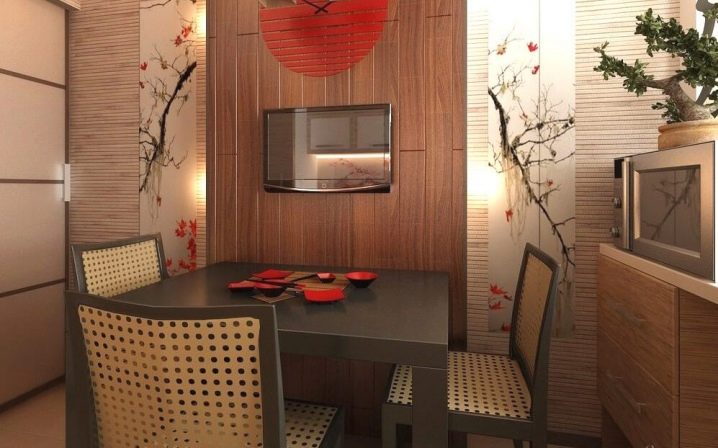
Style features
The Japanese style is similar to modern minimalism, but with a touch of oriental culture. In such a kitchen, everything is thought out to the smallest detail, each thing has its own place. And although it is easier to clean with a minimum space load, you will have to constantly monitor the order. It is difficult to imagine a Japanese ascetic interior with scattered things and dirty dishes left behind.


Despite the seeming simplicity, the furniture in the kitchen is quite functional. It is able to accommodate a variety of modern technology, which is carefully hidden behind opaque facades. The characteristic features of the style can be determined by the following points:
- the direction is inherent in simplicity and grace at the same time;
- perfect order and functionality of furniture allow you to define each thing in its place;
- it is necessary to organize the maximum possible daylight;
- the decoration and furnishings contain only natural materials;
- kitchens are monochrome, without bright blotches; in the setting they use white, black, beige, red, green, brown;
- the interiors of the Japanese style have perfect geometric proportions;
- the kitchen should contain a minimum amount of decor, often with a hint of ethnicity.
The work apron is made in a light palette, for example, white tiles or glass surfaces with elements of ethnic decor are used. In this case, skinal slabs depicting Kanji (hieroglyphs) or a sakura branch are suitable.
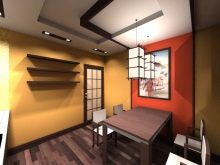
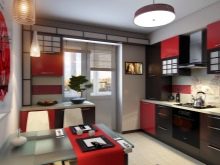
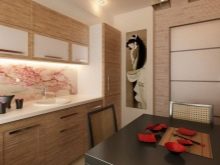
Finishing
For finishing, natural materials are chosen, mainly in light shades. The walls are painted in a solid color. In addition to tiles, wood is used to cover the floor, despite the specifics of the kitchen.
Walls
The furniture, although it looks simple, but it is she and the few decor that create a Japanese theme. The walls in the interior act as a neutral background against which the kitchen set can show itself, emphasizing its belonging to the oriental style.
To create a design for Japanese cuisine, decorative plaster or painting is most often used.
- From all types of plaster, you should choose Venetian. It gives a perfectly flat surface in contrast to rough textured and structural types. The Japanese style prefers simple smooth surfaces, besides, this type of plaster is environmentally friendly, reliable and durable.
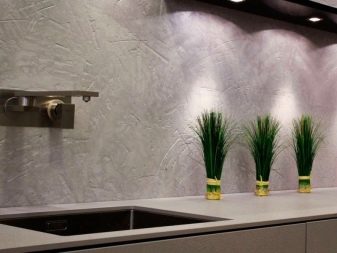

- Water-based compositions are suitable for painting. They are a suspension of water-based pigments without toxic additives, are environmentally friendly and safe. Painted walls have good vapor permeability (breathe), easy to clean even with the use of household chemicals. This is an excellent coating option for kitchens with a gas stove.
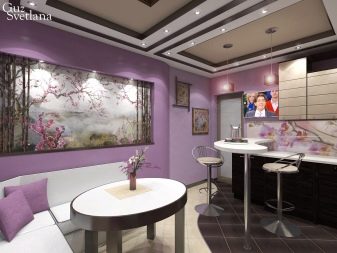
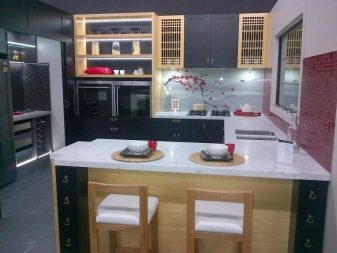
- One of the best wall coverings today is silicone dyeing. They are plastic, capable of hiding numerous cracks (up to 2 mm thick), vapor permeable, environmentally friendly, and contain antifungal additives in their composition.


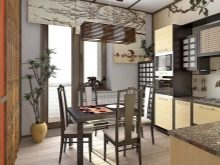
Ceiling
In a modern interior, you can use a stretch ceiling with a Japanese theme print. The top covering is sheathed with wood beams or panels. Structures can be suspended or at several levels.
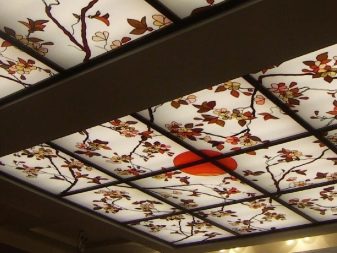
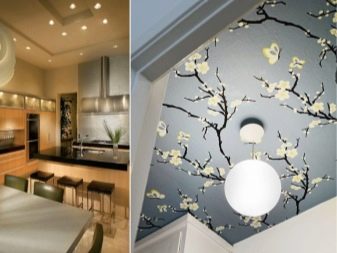
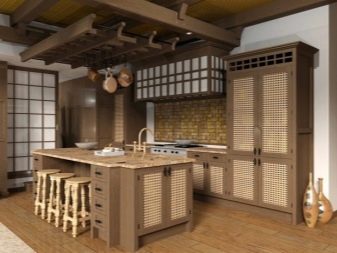

Floor
Wood is used to cover the floor. Anyone who is embarrassed by the presence of wood in the kitchen can use large smooth tiles of uniform shades. She also has a right to exist in oriental interiors.

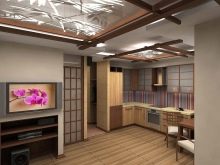
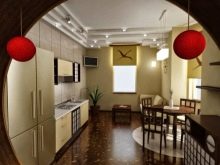
Furniture
In the Japanese style, typefaces are used with straight, clear lines without rounding or asymmetry. Facade panels can be matte or glossy; the door opening system is most often chosen without handles. Showcases with dishes and display equipment are not accepted here. Glass inserts are used in headsets, but they serve to lighten the interior, and not to view the contents on the shelves, so the glass is used with a matte finish. All appliances and kitchen utensils are hidden behind impenetrable facades.
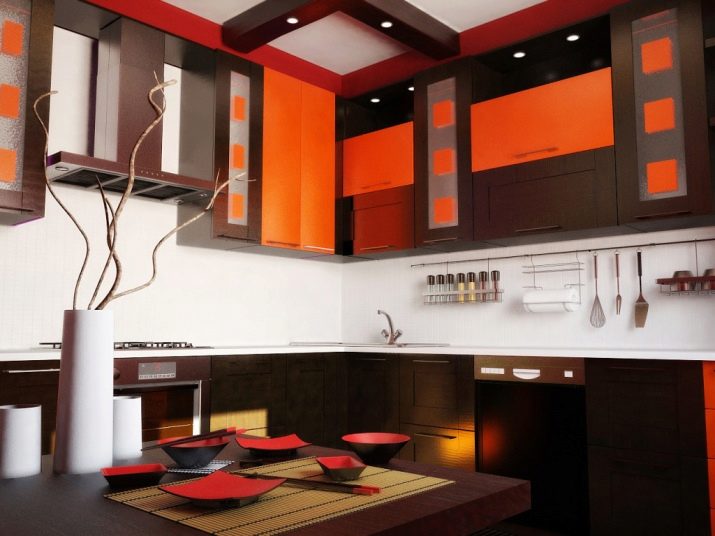

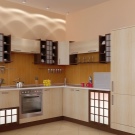
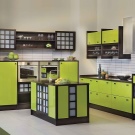
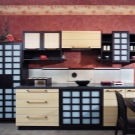
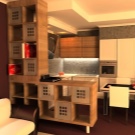
Thanks to TV shows, many have an idea of real Japanese kitchens with tables 10-20 cm high and seating in the form of pillows. In the tradition of our culture, it is difficult to imagine breakfast on the floor. Therefore, observing as much as possible the authenticity of oriental design, we reserve the right to eat as we are accustomed to. The dining group should be made up of a lightweight table of moderate height and the same simple, but not bulky chairs or stools.
In Japanese interiors, it is necessary to avoid massiveness, the whole furnishings are made of wood and other natural materials, it looks reliable, but elegant. There is a lot of air and light in the space.
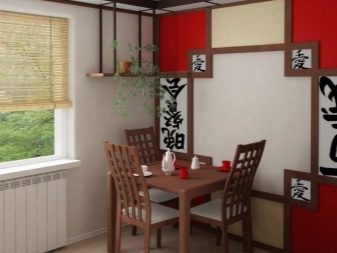
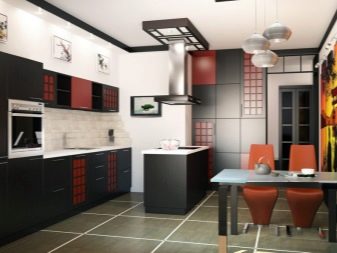

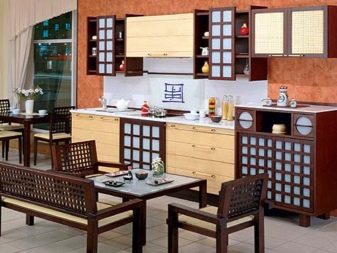
Space decoration
Headsets in an oriental kitchen can be displayed against the walls in any way: in one or two lines, L-shaped, U-shaped. The main thing is that they are laconic and keep enough space around them.
In large country kitchens or studio apartments, you can demarcate territory with Japanese shoji sliding doors. They look like a movable frame with stretched translucent paper. In modern designs, frosted glass can be used instead of paper. The solidity of the glass is crushed by wooden beams, creating a "pattern" of a refined cage.
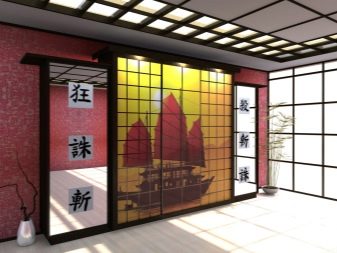
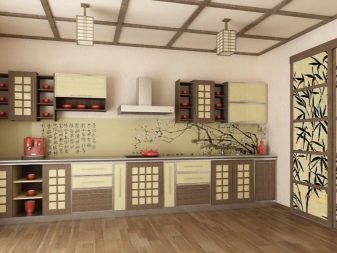
For window decoration, roller blinds or bamboo blinds are suitable, but Japanese curtains will look more harmonious. They represent a sliding structure with straight fabric panels, made in the form of panels (screens). In Japan, they delimited the space of rooms, and the Europeans use them to equip windows.
To complete the interior decoration, you can add a scroll with a Japanese dictum on the wall, a vase with ikebana, living vegetation in the form of bonsai (dwarf trees).
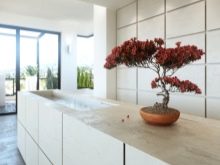
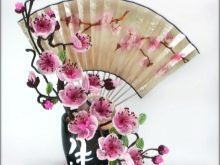

For Japanese style in interior design, see the next video.













The comment was sent successfully.